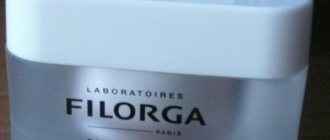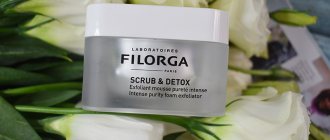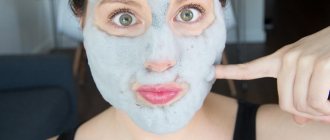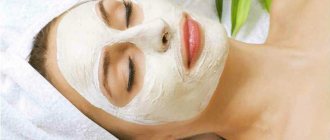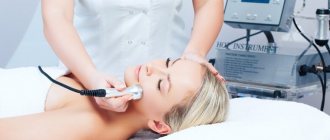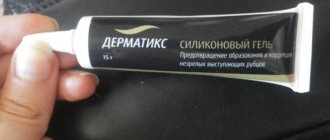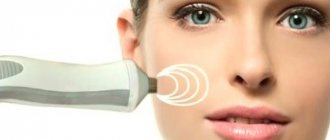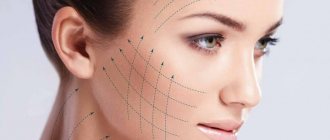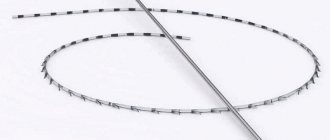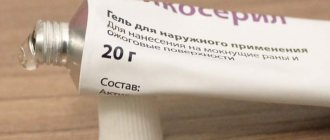What is the procedure
Fractional laser is aimed at the skin and activates regeneration processes. Micro rays provoke a skin burn, after which cells begin to actively divide. As a result, collagen and elastin are produced.
This procedure takes from 30 to 60 minutes. During it, slight tingling may be felt. The technology is quite new, so the features of the laser are not well disclosed.
Benefits of technology
What is laser nanoperforation and what contraindications does it have?
Compared to other laser resurfacing techniques, it is less traumatic, and special radio wave radiation stimulates the natural production of collagen and elastin in the deep layers of the dermis, which allows wrinkles to be pushed out from the inside, smoothing them out.
What is most important is that the positive effect of lifting will only increase in the next six months. A stream of infrared rays effectively fights the signs of photoaging, allowing you to remove pigmentation and wrinkles
All this together allows you to get excellent rejuvenation results.
Indications for the technique
Cosmetologists identify the following indications for fractional laser facial peeling:
– pronounced age-related changes – sagging skin, sagging, gray complexion and senile pigmentation; – photoaging and network of wrinkles; – decreased turgor of the oval face, sagging and loss of tone of the dermis after sudden weight loss; – stretch marks and abundant freckles; – scars and scars after acne or surgery;
The effectiveness of the technique has been proven by the practice of cosmetologists and many positive reviews from patients.
Existing contraindications
For all its incredible effectiveness, the procedure also has its contraindications. These are:
- Diagnosis of oncology and systemic pathologies affecting connective tissue - lupus, scleroderma and other pathologies.
- Keloid types of scars and herpes in the period of exacerbation.
- Foci of inflammatory nature in the laser treatment area.
- Mental disorders and the course of taking retinoids.
- It is not recommended to carry out this method during pregnancy and breastfeeding - just postpone peeling for a while.
What is the procedure
Fractional skin resurfacing involves treating the skin with laser beams of small diameter - they are applied to the selected area in fragments. As a result - cleansing of the dermis, activation of its regeneration and production of natural collagen and elastin in the deep layers.
The session itself is painless, but for a patient with a low pain threshold, the area of skin treated with the laser can be treated with local anesthesia.
Before the actual manipulation, the cosmetologist and the patient put on special safety glasses and a laser beam is directed at the treated area of skin by a gunner. After treating the patient’s skin with special gels, this will help speed up the regeneration of dermal cells, as well as cool and relieve redness.
The rehabilitation period after resurfacing is minimal, the skin restores its firmness and elasticity, becoming smooth and radiant in a short time. In this case, the patient does not experience discomfort, there is no need to change the usual way and rhythm of life.
After 2-3 days, a thin, brownish crust forms on the face, which will disappear on its own after 5-6 days.
Skin care during this period is simple - apply a protective cream against ultraviolet radiation with a filter level of at least 50 before each exit to the street in the summer. Also, during the week you should not visit the sauna or take a steam bath, swim in open water or a swimming pool, or put on makeup.
Session duration
The duration of one laser peeling session depends on the area being treated, as well as the initial state of the dermis, and can last from 30 to 60 minutes.
The positive result of rejuvenation is visible after the first time - to consolidate it, the client is recommended to undergo from 3 to 6 resurfacing procedures, maintaining an interval of a month.
What are the results?
By going through this method, you can effectively and for an acceptable amount of money rejuvenate and cleanse the dermis at a deep level - as statistics and customer reviews show, you can lose about 8-10 years on your face per session. More specifically, the client after the procedure receives:
– rejuvenation after the first session; – lifting effect and tightening of scars; – elimination of all dermal defects and smoothing of the skin and facial tone; – restoration of facial turgor and smoothing of wrinkles, elimination of pigmentation and stretch marks; – peeling helps eliminate the consequences of acne;
Side effects
Fractional laser resurfacing, according to cosmetologists, has no side effects - it does not provoke burns, inflammation or swelling, and does not cause allergies. This makes the procedure itself universal - positive, even incredible, rejuvenation results, painlessness, a minimum of restrictions and the absence of side effects make it incredibly popular.
Fractional laser facial skin rejuvenation
There are two types of fractional laser facial skin resurfacing:
- Ablative . The laser causes tissue dehydration, which results in a lifting effect. There is a risk of infection.
- Non-ablative . The skin is not injured. The regeneration process occurs under the skin. The development of infection is excluded, but the effect is not very noticeable.
The choice of method is made by a specialist, taking into account the individual characteristics of a person’s skin. Before performing the technology, the cosmetologist may prescribe antibacterial and anti-infective drugs. On the day of the procedure, it is better to give up smoking, drinking alcohol and active sports.
Features of skin changes after the procedure and their duration
Laser blepharoplasty
Laser resurfacing is carried out in the presence of acne, persistent wrinkles and pigmentation, disorders of the skin texture, including the presence of hypertrophic or atrophic scars, reduced turgor and sagging skin, etc. on the face, neck, hands and other parts of the body.
For these purposes, carbon dioxide Fraxel is usually used, which is a CO2 laser that acts on the skin according to the principle of fractional photothermolysis. This procedure results in serious traumatic (burn) damage to the skin. After laser resurfacing with a CO2 laser, the exposed area looks like a continuous wound surface, since fractional photothermolysis consists of point structural destruction to a depth of 2 mm in limited areas of the skin under the influence of high temperatures generated under the influence of light (laser) energy. Local changes after laser treatment are as follows.
The main stages of the processes during the recovery period
Restoration of the wound surface begins 1 day after the procedure. Its duration, if the care conditions are properly followed, ranges from 1 – 2 weeks to 1 month, which is influenced by the depth of laser exposure and the individual characteristics of the body.
Immediately after exposure, the entire treatment area becomes sharply hyperemic, that is, it acquires an intense red color, which, to a greater or lesser extent, persists for about 1 month after the procedure. Its intensity also mainly depends on the depth of laser penetration, the quality of skin protection from subsequent ultraviolet irradiation and the influence of other irritating factors, as well as on the individual characteristics of the blood supply in a given area for a particular patient.
In addition to pronounced hyperemia, traces of the influence of the laser beam are noticeable throughout the entire area, which have the form of pinpoint reddish holes located at a certain distance from each other. Brownish spots may appear in areas with excess pigmentation prior to the procedure. Moderate pain, a burning sensation and rawness, as well as weeping due to sweating of serous-hemorrhagic fluid occur.
On the first day, as a result of the active inflammatory process, the influx of blood and the release of its liquid fraction into the tissue, swelling of the latter occurs and increases. When treating the face, it is especially pronounced in the periorbital region, in the area of the lower eyelids and the lower 1/3 of the face, which increases in volume. Swelling reaches its maximum on the second day and gradually decreases from the 3rd to 4th day of the recovery period.
The first week after photothermolysis is the most difficult stage of the rehabilitation period. At this time, as a result of skin damage and weeping, crusts form, rough removal of which can disrupt the healing process and lead not only to infection, but also to the formation of scar tissue.
After laser scar resurfacing, these damages are very limited. Accordingly, activities during the recovery period are usually limited to local care for a small wound. Unlike single scars, stretch marks are located over a large area of skin. In addition, due to the fact that these atrophic scars are located below the skin surface, their correction requires resurfacing of the surrounding healthy skin, rich in small vessels and nerve endings.
In this case, over a large area, not only more pronounced pain occurs, but often intoxication of the entire body. At the same time, the risks of various complications associated with infection of the wound surface increase, and the duration of the recovery period increases.
Indications
It is recommended to carry out fractional laser rejuvenation in the following situations:
- Post-acne . The procedure reduces the visibility of scars.
- Wrinkles around the eyes . The method allows you to eliminate creases, folds and dark circles under the eyelids. Getting rid of deep wrinkles will be difficult. For a noticeable effect you will need at least 5 procedures.
- Wrinkles at the mouth . Laser resurfacing reduces such defects after 4-5 sessions.
- Insufficient elasticity of the skin . The laser gives the epidermis density and elasticity.
- Pigmentation . The method removes dark spots that cause rough skin and spoil the appearance.
The technique is also designed for the following problems:
- sagging skin;
- spider veins;
- warts;
- papillomas;
- dullness of the skin;
- ugly oval face;
- stretch marks.
Rejuvenation courses can be used at any age. Most often they are used for aging skin after 40 years. The procedure is actively practiced after lipofilling and surgical skin tightening.
Fractional CO2 laser rejuvenation
Fractional rejuvenation involves the use of several acupressure techniques. One of the most popular is the CO2 laser. This innovative technique was developed by American and Korean doctors. The laser copes well with wrinkles of varying depths, scars and skin irregularities. The device has a high threshold energy density and allows painless penetration into the layers of the dermis.
The CO2 laser works by heating the top layer. Between the processed points, untouched areas are preserved.
Such rejuvenation is superior to old methods, in which the entire surface of the skin is injured. The likelihood of infection and the development of side effects is minimal. The skin recovers quickly, and the effect lasts for several years.
Experts choose fractional CO2 lasers for ease of use, simple controls, the ability to adjust the size of the illuminated area, and high performance. When purchasing a device, it is important to make sure that the manufacturer is reliable.
How I bought a 40W laser engraver in China + a little theory of CO2 lasers
You may have seen lively videos on YouTube where a laser machine cheerfully cuts plexiglass in a completely crazy way (viewing without sound is recommended). Well, I thought, I need to buy myself such a toy. Moreover, with a 40W laser and black paint you can draw printed circuit boards like this. ATTENTION
Well, I thought, I need to buy myself such a toy. Moreover, with a 40W laser and black paint you can draw printed circuit boards like this. ATTENTION
Do not try to repeat what is written in this article. Working with the cover open is prohibited; mirror adjustment may only be carried out by qualified personnel. Eye protection is required - otherwise you can easily lose your sight.
Brief theory
A regular carbon dioxide laser actually contains Helium and Nitrogen, under pressure below atmospheric pressure.
Low power lasers (100W or less) are usually “soldered off”, i.e. just a glass tube with a buffer volume of gas, water cooling, 2 electrodes at the ends of the tube, and 2 mirrors - one translucent (for radiation with a wavelength of 10.6 μm), the other opaque. As CO2 operates, it decomposes and the laser loses power. The higher the temperature, the shorter the service life (usually 1000-2000 hours). The laser is powered by a high voltage source, ~15-20 kV, 15-25mA (for a 40W tube). 40W is only enough for cutting plexiglass/plywood. Metals can only be cut with much higher power (1000W and above), less if the melt is blown out with oxygen (then the iron and carbon also burn, providing additional energy). It will not be possible to cut tracks directly on a printed circuit board - because... Copper reflects 10.6 µm radiation well. But if you cover it with a thin layer of paint, I have seen positive results. What is noteworthy is that PVC, for example, cannot be cut, because... The gases released when cutting it corrode the lens (and are not entirely useful for humans).
In fact, many of the features of CO2 lasers come from the wavelength of the emitted light (10.6 microns, “far” infrared light) - very few materials are transparent to such radiation. The type of light that transmits this light best is zinc selenide, ZnSe, an orange solid. Significantly worse (but cheaper) are silicon and germanium. From the exotic, ordinary table salt also transmits CO2 laser light well, but lenses made from it are very short-lived.
Mirrors - the cheapest ones are glass or silicon, coated with a layer of copper or gold - as in the photo on the right (at low radiation powers - this is quite enough). In production, there are all-copper mirrors with water cooling, and molybdenum ones - if, when cutting steel, a drop of molten metal sticks to the molybdenum mirror, you can simply pick it off, wipe it with a cloth and continue working
The laser beam can be moved by “flying mirrors” - when both the laser and the cutting object are stationary, or for example there can be one flying mirror + object movement. The laser is usually not moved, because it is very long (due to the fact that it is difficult to increase the diameter of the output beam above 1 cm - increasing the power is only possible by increasing the length).
And finally, focusing is done with a zinc selenide lens. High-power lasers can use a parabolic mirror, which immediately rotates the beam by 90′ and focuses it. Of course, both mirrors and lenses can have an anti-reflective coating (especially in the resonator of the laser tube).
Due to the fact that the radiation wavelength is very long, 10.6 µm - the diameter of the point into which the laser is focused is limited by the diffraction limit: for a lens with a focal length of 101 mm - the spot diameter cannot be less than 0.2 mm, and for 51 mm - 0.1 mm (at beam diameter 7mm).
Looking ahead, my laser tube looks like this:
How I bought an engraver on Aliexpress.com
Having looked at what they were selling on the market, I saw that out of what is not too fatally expensive (<$10,000), only labeled Chinese engravers with a 40W laser sell it.
Naturally, I decided to buy the engraver directly from the manufacturers, without intermediaries. After browsing on aliexpress.com, I found the first seller. After a short correspondence discussing additional spare parts (I wanted to buy a spare laser tube), the seller offered to transfer him money by bank transfer “to my grandfather’s village” and promised to send the engraver immediately after that. I didn’t do this by itself, any purchases must go through alibaba’s escrow system, or through Paypal - otherwise there will be no opportunity to challenge the transaction if they send something wrong. I filed a complaint against the seller, and he quickly disappeared from the site. I found a second seller, but this time he already agreed to escrow. The weight of the parcel exceeded the permissible 40 kg for mail and EMS - so we decided to send it disassembled by EMS, along with assembly instructions. The issue price is $1288 including delivery. A couple of weeks later, the EMS courier had difficulty bringing the boxes to my home:
Opening and collecting
It immediately caught my eye that the protective glass broke during transportation. But so far everything looked optimistic. I put everything together, connected the water cooling, and tried to test the laser. I press the test button - there is a discharge in the laser, but the dot on the piece of paper is not burned. Strange... Even 0.1W paper should burn through. I open the protective cover and inspect everything - everything seems to be good. I press the test - again nothing. Then I suddenly notice that during the test my hand feels warm. Tough. It turns out that the adjustment of the Y-mirror is off, and the laser beam does not hit the X-mirror, but is scattered from the round surface (above - it is circled in red). Then I understand that everything will not go as smoothly as I expected. Well, there is nothing to do, we need to adjust.
Adjusting flying mirrors
I quickly found a clever way of adjusting it - using heat-sensitive paper, on which receipts are printed in stores.
The problem is that there are too many points for adjusting the position of the mirror, and the Y-mirror mount is not quite rigid, the Chinese have their own damn style. Everything was going well, the beam was hitting almost where it needed to be, and suddenly, the next time the laser was turned on for test, smoke began to appear on the left side. The next paragraph flew by in 0.5 seconds I think - hmm... I wonder where the smoke could be coming from, it seems like there’s nothing special to burn... Hmm... A person can “filter out” sensations that he does not expect at all, and is focused on something else (exactly like that However, you may not notice a knife wound in a fight). And then the pain came...
The next paragraph flew by in 0.5 seconds I think - hmm... I wonder where the smoke could be coming from, it seems like there’s nothing special to burn... Hmm... A person can “filter out” sensations that he does not expect at all, and is focused on something else (exactly like that However, you may not notice a knife wound in a fight). And then the pain came...
It turned out that my finger got caught in the laser beam, it’s good that I tested it at the minimum stable power (about 10W). (Photo is not for the faint of heart,
). 3 a.m. What to do? Call an ambulance? “- Hello, what happened to you? “Ahhh, take me away, I burned my finger right through with a laser!!!!”
In general, I was lucky, it hit a nail, the power is low, 10.6 microns is well absorbed, and the wound was superficial (this is why CO2 lasers are used in medicine). It healed quickly. After that, I realized that my path to a working engraver was not close. And I sat down to write a complaint against the seller on aliexpress.
Disputes with the seller
After carefully studying the product, a list of problems with 9 points was discovered - differences from what was in the description, monstrous problems with quality (the power supply produced only 14 mA, although a 40W laser requires 24, the cnc controller was different from what was in description, terrible PCB quality, defective ZnSe lens, “burnt” fingerprint on one of the mirrors). The depth of the problems can be seen in the pictures:
,
,
,
.
It was a real hack. We spent 2 months in disputes at different levels, returning to the beginning of the dispute several times. The seller made a “mistake” - he admitted that he sent me “another model”, but it was “better”. This was his fatal mistake; after that it was much easier to argue with him. I demanded that the entire list of problems be corrected, or I offered to return all this stuff to him at his expense. Of course, while the dispute is ongoing, the seller cannot withdraw his money.
Ultimately, the seller agreed to send replacement parts - a normal power supply (as in the description), a new, non-defective ZnSe lens and 3 molybdenum mirrors. But a lot of nerves were spent.
Laser test video:
Result and conclusions
What I ended up with was a fun DIY laser engraver kit for not too much of a price.
Now I’m making a Mach3-compatible controller for it, it’s difficult to do anything other than stamps with the original one (since the crooked Chinese software is designed for raster engraving, not cutting). But with the Chinese you need to keep your eyes open - they do not hesitate to sell defective goods just to earn an extra $10 (that is, they can do quality work, but only if you hold them by the throat. If you don’t hold them, you will immediately get rejected). No transactions without Escrow and no possibility to dispute the quality after delivery.
Comments, questions, additions?
Contraindications and side effects
Complete contraindications include:
- period of bearing a child;
- lactation;
- tendency to form scars;
- oncological diseases;
- chronic infections;
- weak immunity;
- psoriasis at the acute stage.
Fractional laser rejuvenation has relative prohibitions:
- renal pathologies;
- increased blood glucose;
- mental disorders;
- recent sunbathing.
Within two days after laser resurfacing, the following symptoms are observed:
- redness;
- swelling;
- discomfort;
- dryness;
- peeling.
To alleviate the condition, use painkillers and cool the skin. After a while the face looks a little tanned. There is no need to do anything about this connection.
To get rid of puffiness in the eyes and nose, you need to take care of removing water from the body. It is necessary to eat less salty foods and hot spices. It's better to take a diuretic. The appearance of ichor is considered a natural reaction. When the scab peels off, a new layer of skin will appear underneath. You should not try to pick off the dry areas yourself, otherwise it may leave scars.
Rarely, the patient is bothered by a rash, itching, or different skin color. With time everything will pass. Side effects are more common for women with sensitive skin.
To avoid possible complications, it is advised to look for experienced cosmetologists with the appropriate skills. The key to a successful procedure will be choosing a good specialist.
Rehabilitation period after laser facial resurfacing
In the first day, the face will turn pink-red, you will feel a pulsation, and the skin will seem to be burning. Ichor may be released, and with active facial expressions it may even bleed. Somewhere on the second or third day, a crust will appear at the site of the redness, which will dry out and peel off every day. Due to dryness, severe itching and slight tingling may be felt, but you must be patient and try not to touch your face with your hands at all. Even then you will be able to see new, soft and slightly pinkish skin.
Under no circumstances should you tear off the resulting crust yourself, otherwise scars may remain. The crust should gradually peel off on its own.
Facial skin treatment after laser resurfacing
If you decide to undergo laser resurfacing, you should treat the procedure as a serious operation after which you must strictly follow the rules of rehabilitation. Perform all procedures prescribed by a cosmetologist, using the products that were selected individually for you.
Washing your face during the recovery period
During recovery, you will have to give up running tap water and standard washing in general. Until the skin regains its original appearance, you need to use a spray bottle. Lightly spray your face with boiled or bottled drinking water. After such water procedures, it is better not to dry yourself with a towel, but to let the water absorb. If this option is not suitable, simply pat your skin lightly with a soft natural towel. After washing, some cosmetologists advise treating the skin with a weak vinegar or saline solution.
Reviews
Women note the following benefits of fractional laser rejuvenation:
- impact on any area of the face;
- a large list of indications;
- long-lasting effect (about 1 year);
- rapid recovery (3-5 days).
There is information that the pain was quite severe. However, everyone has their own sensitivity threshold. Everyone's reaction to pain medication is different.
Of the minuses, the following points are noted:
- the likelihood of developing allergies;
- long recovery period;
- high price;
- the need for several sessions.
Judging by reviews on the Internet, puffiness and bags under the eyes make the face look older. For advanced deep wrinkles, the procedure is useless.
It is worth noting that when combining 2 types of fractional effects, the result lasts for at least 2 years. It has been noticed that people with dark skin tolerate the procedure more easily.
Rules for recovery after the procedure
After rejuvenation it is recommended:
- do not wash your skin with scrubs in the near future;
- protect the outer cover from sun exposure;
- Use moisturizing creams daily for 2 weeks;
- Avoid cosmetics that contain retinol and salicylic acid;
- try not to smoke or drink alcohol;
- do not visit the bathhouse, sauna and solarium;
- protect the skin from mechanical influences;
- use decorative cosmetics only after 7 days;
- Do not use cleansing masks or abrasives.
To maintain the results for as long as possible, you should regularly visit a cosmetologist and undergo a full course of rejuvenation. Experts advise not to rush into such procedures, find out about all the contraindications and choose a high-quality clinic that has real reviews. They also advise leading a healthy lifestyle, exercising and taking care of your skin. This is the only way to prolong youth and improve your appearance.
Stages of skin preparation for laser procedures
Laser facial resurfacing for a new radiance of the skin
What needs to be done to prepare the skin for laser hair removal?
Look at the calendar and select a time
Elena Lykova Dermatologist, cosmetologist, director of the SkinCeuticals brand in Russia
“Aggressive lasers (for example, CO2) are extremely undesirable in summer. Softer ones (Fraxel) are possible, if, of course, there is an urgent need for them. Laser hair removal of the upper lip, arms and legs is also not recommended in the summer. In any case, a month before the intended laser procedure, during and after it, it is necessary to use antioxidants in the form of serums for the skin.”
Your own schedule, no matter how busy it may be, in this case fades into the background. Laser procedures are not carried out in the sunny season, as they increase photosensitivity of the skin and can provoke the formation of age spots.
It is best to go for a laser procedure in the fall and on Friday, when there are two whole weekends ahead.
Ideal time: autumn or winter
It is important that at least a month has passed after the beach season, plus at least another month remains until the next period of increased solar activity after the end of the course of procedures
At the same time, in order to undergo a course of laser hair removal, you need to be patient: the number of procedures will be determined by the doctor, and it can range from 6 to 12. And the interval between manipulations can reach a month.
Such a long period between procedures is due to the ability of the laser to affect only hairs in the active growth stage. And in the skin there are simultaneously hairs at different stages of development. Typically, 10–25% of hairs are removed per session.
Protect your skin from stress
At least two weeks before the procedure, start paying special attention to skin care
- If you don't already, start using sunscreen on exposed skin as soon as possible.
- Keep your skin moisturized. This is mandatory regardless of the procedures you undergo. Only well-moisturized skin can fully function and has sufficient potential for self-healing after laser exposure.
- Start using antioxidant serums on a regular basis to strengthen your skin's defenses and increase its regeneration capabilities.
- If you are planning laser peeling, use serums and homemade peels with fruit acids a week before the procedure.
For example, such as the Retexturing Activator renewing moisturizing serum, SkinCeuticals.
Antioxidant serums are necessary both to prepare the skin for laser procedures and for its speedy rehabilitation.
Avoid other types of hair removal
2-4 weeks before laser hair removal of any area, it is necessary to exclude waxing or any other method of hair removal other than shaving. You shouldn't lighten your hair either.
What is the difference between depilation and hair removal?
Price
The cost of fractional rejuvenation depends on certain factors:
- cosmetologist qualifications;
- the device used;
- the nature of the problem;
- type of fractional impact;
- surface area;
- pricing policy of the organization.
The average cost of a session in Moscow is 11,500 rubles. In the regions, the price for the procedure varies from 8 to 10 thousand rubles. In some clinics it reaches 25-30 thousand rubles.
The final amount depends on the area of influence. You can select the entire face and neck or one of the following options:
- area around the eyes;
- forehead;
- cheekbones;
- cheeks;
- temporal zone;
- chin.
If desired, it is permissible to treat the forearms, décolleté, abdomen, chest or hands. You should not trust dubious clinics that offer to perform the procedure at a suspiciously low price.
Before and After Photos
On the Internet, you can find a considerable number of photos before and after fractional rejuvenation. In the first days, the face takes on a not entirely aesthetic appearance, but after 7-10 days you can see an excellent result. The pictures show the following changes occurring:
- the oval of the face is tightened;
- the skin becomes clean and smooth;
- skin tone is evened out;
- acne scars go away;
- blackheads around the nose lighten up.
After laser rejuvenation, the skin becomes fresher and smoother. Large wrinkles are reduced in size. Severe pigmentation disappears. In any case, the laser effect has a lot of advantages, which can be judged from the photos presented.
Article Rating
